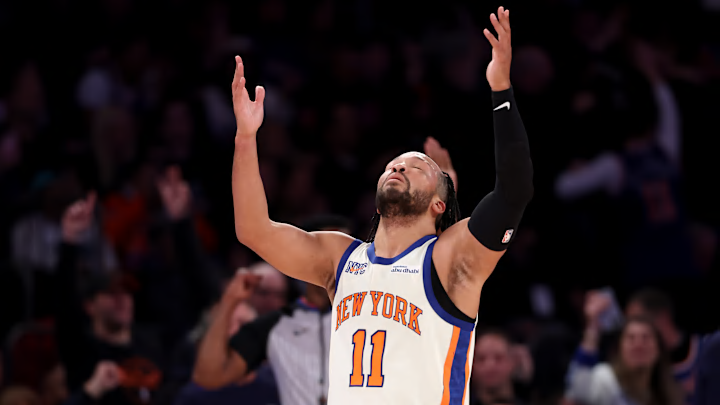The New York Knicks didn’t need a slow buildup to adversity this season. They walked straight into it. Jalen Brunson sprained his ankle. OG Anunoby strained his hamstring again. Mitchell Robinson missed time. Karl-Anthony Towns continued adjusting after the trade.
It felt like the exact scenario analysts warned would expose the Knicks’ biggest flaw. For years, depth wasn’t just a talking point. It was the defining criticism of the Knicks.
Every preview, every hot take, and every playoff breakdown circled the same conclusion: the Knicks were good, but not deep enough to withstand real losses or to make a deep playoff run. One sprained ankle could derail a week. Two injuries could derail a season.
Now the Knicks face the very test experts predicted would break them. The Knicks rank second in a tight Eastern Conference, and there are signs they might finally be equipped to have a more sustainable season—the injuries are expected to be short, and Brunson is listed as day-to-day.
Injuries once destroyed New York but now reveal something different
Against Miami, the Knicks entered the game without Brunson, and Anunoby had to leave early—two starters who define their spacing, shot creation, and perimeter defense. In past years, that would have been the beginning of a downward spiral. Instead, New York exploded offensively and looked completely in control.
Karl-Anthony Towns carried the scoring load with 39 points, 11 rebounds, and 4 assists in 38 minutes, playing like a true offensive anchor. Mikal Bridges added 15 points in 42 minutes, while Josh Hart delivered one of his most complete performances of the season with 10 points, 12 rebounds, and 10 assists.
Jordan Clarkson came off the bench and gave them 24 points in just 33 minutes, providing the type of instant offense the Knicks simply didn’t have in years past. Landry Shamet followed with a massive 36-point eruption in 37 minutes, stepping into the scoring vacuum with complete confidence.
Even Miles McBride contributed 9 points in 30 minutes, playing under control and offering defensive pressure without disrupting rhythm. Some might say they play with more grid, like back in the days.
The supporting cast didn’t just fill minutes, but they enforced pace, attacked switches, and stabilized the offense. Yabusele chipped in key stretches, Hukporti held the paint in spot minutes, and the entire rotation functioned as if nothing had been lost.
New York didn’t merely survive missing Brunson and Anunoby. They imposed themselves on the game. Injuries used to expose how little help the Knicks had behind their core. Now they reveal how much stronger, deeper, and more balanced this roster truly is.
Depth used to be New York’s biggest flaw and now it’s a strength
For years, the Knicks’ issue wasn’t talent at the top; it was what happened when they had to reach deeper into the rotation. That reputation followed them into this season, fueling doubts about their ceiling. But the production tells a different story.
Towns is averaging over 21 points and 12 rebounds. Brunson sits at 28 points per game when healthy. Bridges and Anunoby both contribute over 15 a night. Behind them, Clarkson, Shamet, and McBride combine to give New York nearly 30 bench points on most nights. Hart remains one of the most complete role players in the league. Even the rookies provide steady minutes without panic.
This isn’t a team leaning on exhausted starters to carry unstable units. This is a roster with interchangeable scoring, playmaking from multiple positions, and a bench capable of winning quarters outright.
Towns’ evolving role proves the Knicks have multiple ways to win
Karl-Anthony Towns’ adaptation to New York has been heavily scrutinized, but much of that noise misses the larger picture. His role flexibility gives the Knicks an element they’ve lacked for years.
When he becomes the primary scorer, as he did against the Heat, the Knicks can lean into a stretch-five offense that bends defenses. When Brunson is healthy, Towns seamlessly shifts into a secondary creator. When Bridges needs more touches, Towns’ gravity still anchors spacing.
This isn’t instability, but it’s versatility. And versatility is depth. In previous seasons, the Knicks had one formula for success. This year, they have several. That is the hallmark of teams built to survive long seasons, injuries, and playoff adjustments.
The Knicks are responding like contenders
The injuries aren’t a minor inconvenience. They are the exact stress test analysts said would reveal the cracks in the roster. The timing is brutal, the absences are real, and the games matter. However, the reaction is also real.
The Knicks are not folding under the weight of missing Brunson and Anunoby. They aren’t asking their stars to play 44 minutes or forcing role players into uncomfortable responsibilities. They’re winning through structure, balance, and contributions from every layer of the rotation.
This is the version of the Knicks that critics didn’t believe existed. The version that can take a punch, tighten rotations, trust their depth, and still execute. The version that isn’t one injury away from disaster.
Experts said this flaw would doom them. The Knicks are showing it might be the flaw they finally outgrew.
